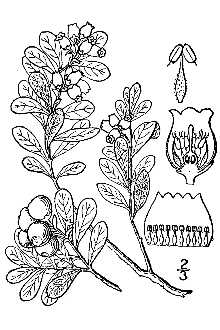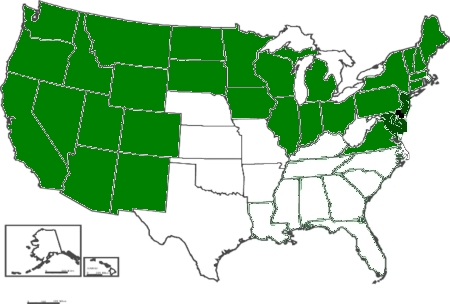Uvularia puberula
 |
|
Photo Courtesy Renee Brecht |
Britton & Brown |
| Botanical name: | Arctostaphylos uva-ursi |
| Common name: | bearberry |
| Group: | dicot |
| Family: | Ericaceae |
| Growth type: | forb/herb |
| Duration: | subshrub; shrub |
| Origin: | native |
| Plant height: | thick, prostrate, trailing sub-shrub; to 6" |
| Foliage: | simple leaves, alternate, broadleaf evergreen, leathery, approximately 1" long with rounded tips. Foliage changes from dark green to reddish-green to purple in the fall |
| Flower: | terminal clusters, small urn shaped, white to pink; bears a bright red to pink fruit (drupe) app. 1/4" - 1/2" in diameter. |
| Flowering time: | May - June |
| Habitat: | sandy soils |
| Range in New Jersey: | reported from three localities on the Palisades and mountains of the northern counties and frequent in the central Pine Barrens. |
| Heritage ranking, if any: | n/a |
| Distribution: |  |
| Misc.: | Stone, in 1910, says: ""This is one of the most characteristic of
the plains of the Pine Barrens, though it is not so closely restricted
to this area of dwarf vegetation as is the Corema. Both are northern
species of wind-swept coast and mountain top, which here find their
southernmost limit. Mr. C.F. Saunders says of it in this region: 'In some laces the Bearberry formed a veritable carpet, the dry, astringent berries not yet tinged with the crimson that makes them so conspicuous in winter. The gathering of this plant for shipment to the cities, where it has been more or less extensively employed in medicine, used to be a considerable industry in southern New Jersey. A reminiscence of this old-time trade still lingers in one of the common names of the plant down there, viz., Uvursy--the shop name of the berry being uva-ursi.' In early spring the plant is particularly attractive when we find among the dark, shining evergreen leaves the tiny little urnshaped pink and white blossoms, like diminutive Huckleberry flowers, but far more delicate. In mid summer, on the white sandy wastes, the dense mats of foliage of the Bearberry offer welcome shelter to various grasshoppers, lizards, etc., which go scuttling away as their retreat is threatened." (621. The drupes are eaten by several species of songbirds and game animals; deer will occasionally browse the foliage. For more information, see the USDA pdf. |